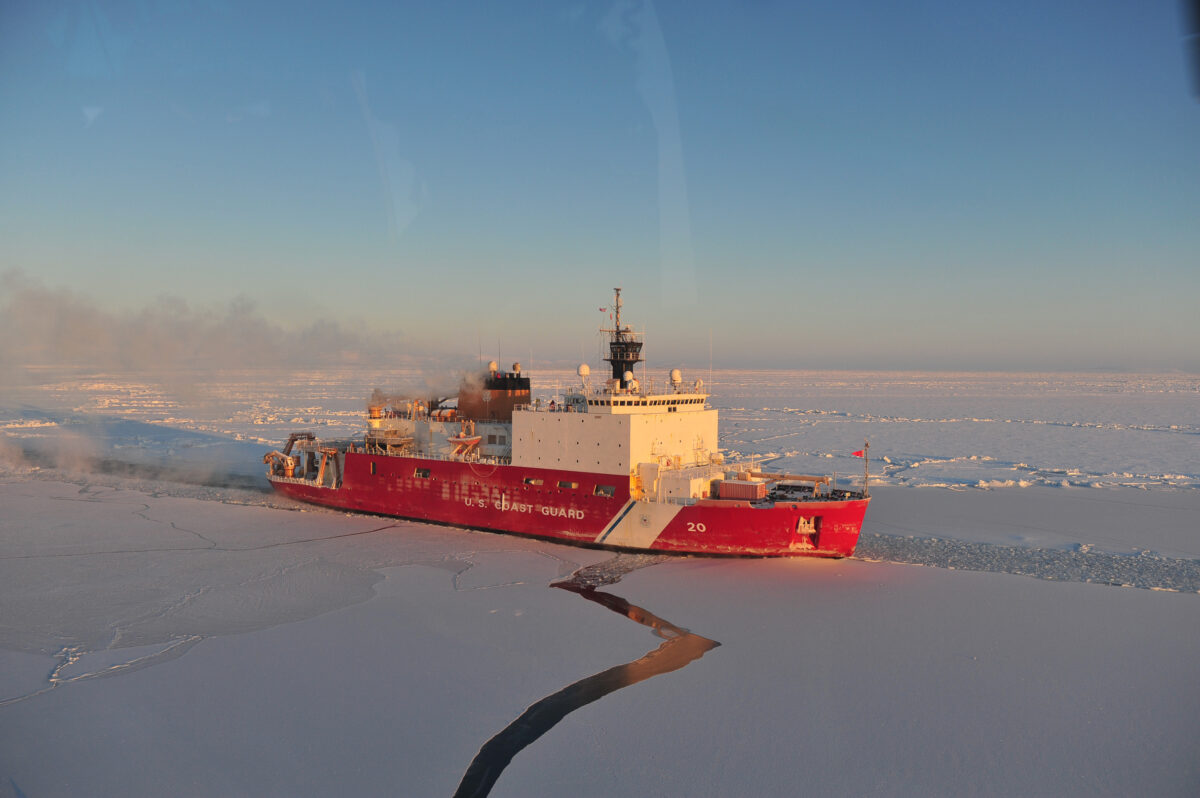Researchers recently disembarked the U.S. Coast Guard cutter Healy in Nome after spending three weeks studying the Chukchi Sea and waters further north. They say there are several changes going on in Arctic waters that they don’t yet understand, so the venture was exploratory in nature.
KNOM’s Davis Hovey reports on the observations the research team shared during a University of Alaska Fairbanks Northwest Campus presentation:
What scientists know based on their research this month is there is evidence that abnormally warm waters in the Bering and Chukchi Seas will continue for years to come.
“And I think it’s becoming somewhat clearer that it’s really a trend; it’s not just a one-off, it’s not just variable stuff from year to year.”
Bob Pickart from the Woods Hole Oceanographic Institution was the head of the research team onboard the Healy this month. Being a physical oceanographer, Pickart illustrated how water circulation impacts the Chukchi and Bering Seas. He found that the circulation in those waters is very sensitive to wind, especially when it blows in from the northeast.
“So, we can go out for three weeks, and the weather is really nice for the first few days, and then all of a sudden, a storm comes by, and the circulation becomes completely different. And then the storm passes, the circulation goes back to something else. So, it’s really difficult for us to go (on) one cruise and say, ‘hey, this is what’s happening,’ because we get this mish mash of all this other stuff.”
So, to compensate for a reversal or huge shift in the water circulation, the research team used data sets from previous research cruises since 2003, which included eight cruises total.
While on this latest research cruise in the Chukchi Sea, Pickart found circulations of converging pools of nutrient-rich water northeast of Wainwright and Utqiagvik. This creates a hotspot which leads to enhanced benthic activity: essentially more prey for large populations of seabirds, marine mammals, and other animals.
In addition to creating healthy hotspots, Pickart believes the same water circulation from the Alaskan Coastal current, which he refers to as the “superhighway,” also helps distribute potentially harmful Alexandrium cysts in the Chukchi Sea.
“They’re not alive, and the water is too cold for them to germinate, so they come into the Chukchi Sea, the circulation slows down north of Cape Lisburne, and then these things settle into the bottom. So you can just imagine that over decades, these things have been coming into the Chukchi and are just settling down in this one spot. Then all of a sudden everything warms up, it hits 4 degrees (Celsius), and bingo: these guys come to life, they float up, and you get a Harmful Algal Bloom.”
According to Pickart, the hotspot and accompanying cysts wouldn’t have been present decades ago because of more sea ice coverage during the fall, preventing more sunlight and nutrients from pooling in these areas.
During their three weeks aboard the Healy, Pickart and his team observed some Harmful Algal Blooms (HABs). One was near Point Hope.
Dead seabirds were also seen in the same region where high toxins were present, but the HABs’ effect on these birds is still unknown. Pickart says one very starved bird was taken from the area for sampling, but it will take time to have results from that testing.

Besides measuring some HABs, the research crew on the Healy focused on other studies. According to Janet Duffy-Anderson, a research fisheries biologist with the National Oceanic and Atmospheric Administration also onboard the Coast Guard vessel, the spring phytoplankton bloom this year was delayed in the Northern Bering sea by a month.
“When there’s a change in the timing of production of algae, you also have a potential for a mismatch in the timing of production of zooplankton. If the algal production is late, then the zooplankton that feed on that algae and depend on it are potentially mismatched, and you won’t have an important prey source established in the summertime for seabirds, fish, and mammals.”
The lack of sea ice in the Northern Bering is the cause for this delay, which Duffy-Anderson says can also change the copepods and prey community that seabirds and marine mammals rely on.
She has studied the Bering Sea for almost thirty years. These types of changes mirror what Duffy-Anderson has observed in the Southern Bering Sea since 2001, following back-to-back years without sea ice.
However, she says it’s hard to know how long larger shifts will continue in the Northern Bering and Chukchi Seas, or what their ecosystems will look like if these shifts do continue.
“We were always under the impression that the Northern Bering Sea behaves differently because of its proximity to the Chukchi Sea and because of the light conditions that are present in the Northern Bering Sea. We thought that the Northern Bering Sea would be much more favorable to continued winter sea ice formation. So we have been really shocked to see how quickly this change has occurred in the Northern Bering Sea. And part of the question that we have is: Is it going to respond like the South (Bering Sea), or is it something different?”
Duffy-Anderson says the research team is working as fast as they can to answer that question.
Scientists with NOAA Fisheries will continue conducting various surveys in the Chukchi Sea through October. A Woods Hole research team will come back in 2020 around the same time of year to focus solely on Harmful Algal Blooms.
Image at top: file photo: The Coast Guard cutter Healy breaks ice in the Nome Harbor, Jan. 13, 2012. Photo: U.S. Coast Guard.





